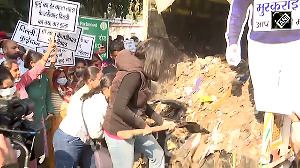Natural disasters have begun to strike India with monotonous regularity. Cyclone in Orissa, earthquake in Gujarat, tidal wave in the Bay of Bengal -- it just goes on and on and on.
A recent paper * by Eugene Gurenko and Rodney Lester of the World Bank estimates that between 1996 and 2001 direct losses from various natural disasters amounted to almost $14 billion.
The government applies band aid because that is all it is capable of doing. Even when it wants to do more, it can't. It is altogether too sclerotic.
Not just this. Gurenko and Lester say that the "frequency of weather-related catastrophic disasters appears to be increasing over time in some regions." You bet.
And not just this, either. As India becomes richer, the economic costs of these disasters will progressively increase. Richer countries suffer greater economic losses, even if poorer countries suffer more in human terms.
And, of course, we all know that it is far harder for the poor to replace their assets than it is for either the rich or the government, which can rebuild public assets merely by taxing everyone.
We have known all this for a long time. And yet, we do not have an institutional mechanism for insuring the poor (and even the not-so-poor) against disasters.
This would have been understandable if there had not been any models to copy. But even that is not true. There are plenty of models available in other countries.
"The most well known of these programmes," say Gurenko and Lester, "include the TCIP in Turkey, FONDEN in Mexico, the Florida Hurricane Catastrophe Fund, the Hawaii Hurricane Relief Fund, the California Earthquake Authority, the Earthquake Commission (EQC) in New Zealand, Catastrophe Naturelles (CatNat) in France, and Norway's Norsk Naturskadepool."
That is enough to go on with for the moment, and perhaps the finance minister, instead of resorting to knee-jerk cesses, should get some of his clever advisors to study these models. Well directed hard work pays, you know.
The TCIP model, created after the 1999 Marmara earthquake, provides insurance against earthquakes. Its key feature is that earthquake insurance cover is compulsory. The World Bank, the Turkish government, private insurance markets and international re-insurers developed this facility.
Basically, it is designed to provide immediate funding for rebuilding assets (in this case homes) and to reduce the fiscal burden on the government. One important side-effect or positive externality is the emergence of better house-building standards.
"The key constraint on insurance market development is low per capita incomes, since low-income consumers have less discretionary income, fewer assets to insure, and are expensive for commercial insurers to reach and service."
Moreover, what is called insurance density, or premium per capita, depends on per capita income and it is hard to get around this core fact. Nor is it easy to ignore poverty. In poor countries like ours, thanks to a combination of mis-management and absence of market forces, insurance companies are usually undercapitalised. They would certainly go bust if they had to pay out for natural disasters.
This has meant that re-insurance has had to be done through the international market, where thanks to the increasing frequency and scale of natural disasters, prices have become very volatile.
The answer is state-mandated disaster insurance. More and more countries are going in for it and so far there are 11 in operation.
"Each of these catastrophe insurance programmes emerged following highly devastating natural disasters to address the subsequent inability of the local insurance market to provide affordable catastrophe insurance coverage for a specific peril."
These programmes provide regionally-based coverage for homes and contents against specific natural hazards and usually don't receive direct government subsidies. They also help alleviate political pressure for allocation of government resources after natural disasters for reconstruction of private housing and businesses.
Until now, India lacked private insurance companies. But now that it does, the government needs to rope them into the task of risk management from natural disasters.
* Rapid Onset of Natural Disasters: The Role of Financing in Effective Risk Management -- Insurance and Contractual Savings Practice, World Bank Policy Research Working Paper 3278, April 2004.







 © 2025
© 2025